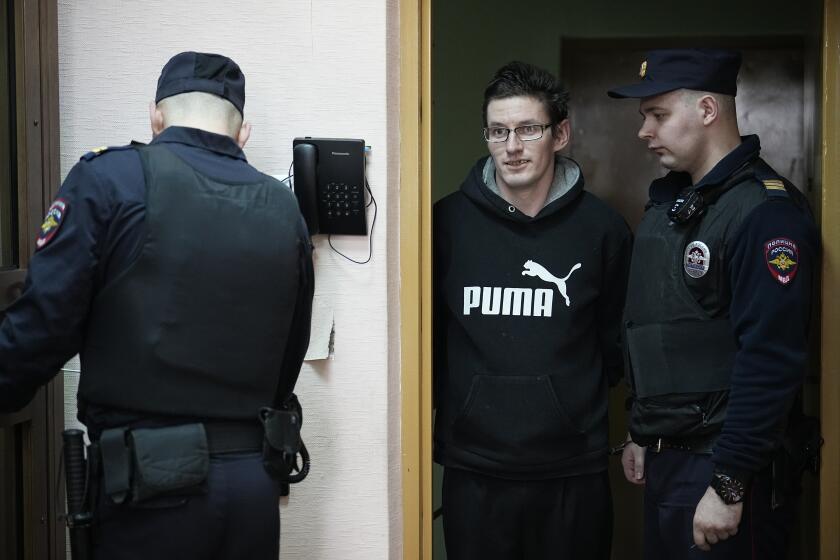Kansas, facing a huge budget deficit, wonders what to do next. Consensus is elusive
The financial woes of Kansas, which is facing a colossal budget shortfall, took another odd twist this week, and an already messy situation got even messier.
State government expenses are estimated to outpace income by about $1.1 billion through June 2019. So how to balance the budget? The answer has proved elusive, and the debate over what to do has embroiled the governor, lawmakers and, on Thursday, the state Supreme Court.
Depending on the point of view, what’s happening in Kansas reflects disciplined government spending or a foolhardy bet that tax cuts would boost the economy. Here are key things to know about the budget crisis that’s being watched by liberals and conservatives from across the country.
What happened Thursday in the Kansas Supreme Court?
The state’s high court ruled that Kansas schools are not adequately funded by the Legislature.
Was it expected?
Definitely. The Supreme Court already ruled last year that there was a grave disparity in state funds received by rich districts and poor districts.
A key issue concerns language. Kansas operates its education budget under a court ruling dictating that funding among all its schools must be adequate (they must be given enough money to operate) and equitable (it must be shared fairly).
In 2016, a majority of the high court found that Kansas school funding was inequitable, setting off a frenzied period of uncertainty in the state capital, Topeka, where lawmakers were given a June 30, 2016, deadline to fix the formula or face the shutdown of all Kansas public schools.
Sounds like a standoff. Was it?
Oh yeah. And the legislators blinked, rearranging the budget to add $38 million to schools.
But then lawmakers who opposed the court’s ruling fought back by dragging the justices who composed the majority into expensive retention races in November.
All the justices won, kept their seats and ruled against the school funding formula again Thursday.
Back up, how did we get here?
There are hundreds of bar graphs and pie charts and, someday, probably cartoons to illustrate this, but the very quick version is: Gov. Sam Brownback proposed dramatic cuts to personal income tax receipts in 2012, a position consistent with the tea party movement that aimed to take spending out of government hands.
The Legislature approved the tax cuts. The strategy has faded somewhat nationally but lives on as the governing philosophy in Kansas, even though the cuts did not spur economic growth as their proponents predicted. Result: the gaping holes in the state budget.
What are the schools like now?
In rich areas like the Kansas City suburbs, they’re fine. In poor areas, not so good. That’s what the Kansas Supreme Court said in its ruling Thursday:
“Not only is the State failing to provide approximately one-fourth of all its public school K-12 students with the basic skills of both reading and math, but that it is also leaving behind significant groups of harder-to-educate students.”
Is it a failing of individual districts, or is the court criticizing the whole school funding formula?
The court is saying that Brownback’s entire block grant funding system will not work for schools. A block grant “is only minimally responsive to financially important changing conditions such as increased enrollment.”
What happens now?
Lawmakers have until June 30 to come up with a new school finance formula, which is expected to cost the state $500 million to $1 billion on top of its $6-billion education budget.
School funding advocates have pushed legislators to complete a new funding formula much sooner. Legislators opposed to the change to the school funding formula wondered aloud Thursday where the money would come from.
What about those legislators? If there was no impetus to change things after 2014, when the state Supreme Court said disparities in school funding violated the state constitution, why would they budge now?
A lot has changed since 2014 — primarily, elections.
More than 20 allies of Brownback lost their seats in November’s election. Democrats and moderate conservatives made education a central issue of their campaigns. Those Brownback allies who did survive mostly skirted the issue of school funding in their campaigns.
If lawmakers can’t cut from the schools, where will they cut?
Well, that’s going to be the next tough conversation in what is sure to be a series of tough conversations among GOP lawmakers looking to fix budget deficits in the next 30 months. That’s about the time it will take for the state’s budge deficit to hit $1.1 billion. In the meantime, the state hopes for more revenue from an increased sales tax.
And what about Brownback’s budget cuts overall — what effects are they having?
So far, not good. Legislators are desperately trying to repeal Brownback’s personal income tax cuts and exemptions for 330,000 farmers and business owners, but they can’t quite get the requisite support.
Just last week, Brownback vetoed a bill that would have ended his income tax cut, and when legislators tried to override his veto, Brownback’s allies squeaked out a win.
It was close, though. The House voted 85 to 40 to override, one more vote than lawmakers needed. The Senate rejected the veto override 24 to 16, three votes shy of an override.
Though the override failed, it’s notable that it came close to passing in a Legislature controlled by Republicans.
Is that ominous for Brownback?
Good question.
Twitter: @nigelduara
UPDATES:
5:50 p.m.: The story was updated throughout with additional background and context.
The story was originally published at 9:35 a.m.
More to Read
Start your day right
Sign up for Essential California for news, features and recommendations from the L.A. Times and beyond in your inbox six days a week.
You may occasionally receive promotional content from the Los Angeles Times.







